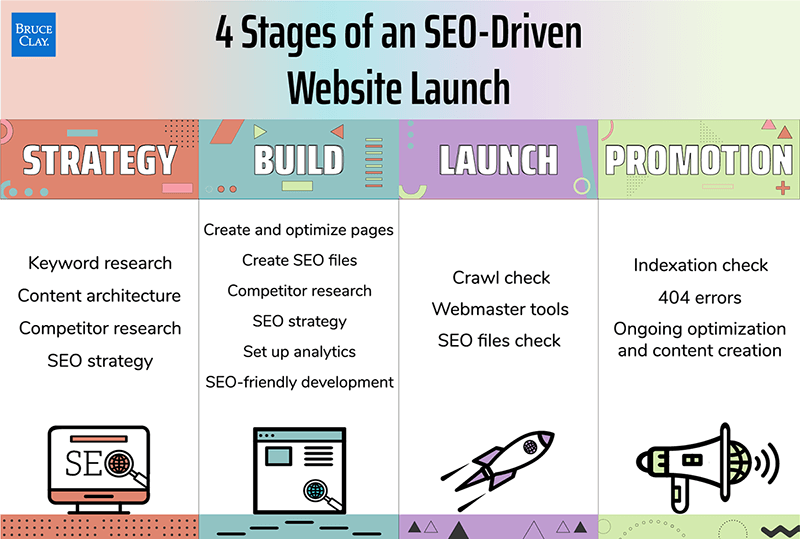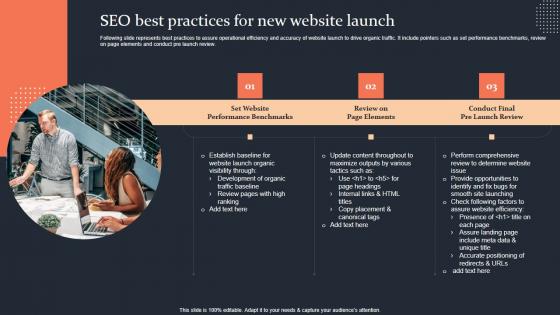Unlock the secrets to skyrocketing your online presence with our ultimate guide to mastering SEO best practices for new websites!

Image courtesy of via DALL-E 3
Table of Contents
Introduction to SEO
SEO, or Search Engine Optimization, helps your website be noticed by search engines like Google. This guide is all about showing you easy steps to make your new website popular.
Why SEO is Important
SEO is like a magic spell that helps people find your website when they search online. Imagine you have a cool new website with lots of fun stuff, but if no one can find it, then all your hard work might go to waste. SEO is the secret potion that makes sure your website shows up when someone types in a search on Google.
How Search Engines Work
Search engines are like super smart robots that zip around the internet, collecting information about all the websites out there. When someone searches for something, these robots quickly scan through their huge database and show the most helpful websites first. So, when you use SEO, you’re basically giving these robots a map to find your website faster and show it off to everyone looking for cool stuff online.
Choosing the Right Keywords
Keywords are the words that people type into search engines like Google when they are looking for information. Choosing the right keywords is essential for making sure that your website shows up in search results. By using the right keywords, you can help your website be more visible and attract more visitors.
What are Keywords?
Keywords are like clues that tell search engines what your website is about. When someone types a keyword into a search engine, it looks for websites that are related to that keyword. By including relevant keywords on your website, you can increase the chances that your site will show up in search results when people are looking for information on that topic.
How to Find Good Keywords
Finding good keywords is a lot easier than you might think. One simple way to start is by putting yourself in the shoes of your audience. Think about what words or phrases they might use when searching for information related to your website. You can also use free keyword research tools to help you discover popular keywords that are relevant to your content.
Creating Quality Content
When it comes to your website, creating quality content is crucial. Quality content is what keeps visitors engaged and coming back for more. In this section, we’ll discuss what quality content is and the different types you can create to make your website stand out.

Image courtesy of www.bruceclay.com via Google Images
What is Quality Content?
Quality content is information on your website that is helpful, engaging, and easy to understand. It should provide value to your visitors, whether it’s answering a question they have, solving a problem, or entertaining them. Good content is also well-written, free of errors, and formatted in a way that is easy to read.
Types of Content to Create
There are various types of content you can create for your website. Some popular options include:
- Blogs: Writing informative articles on topics related to your website’s niche can help attract visitors and establish you as an expert in your field.
- Videos: Creating videos can be a great way to engage your audience and convey information in an easily digestible format.
- Pictures: Using high-quality images and graphics can make your website visually appealing and help break up text-heavy pages.
By diversifying the types of content on your website, you can appeal to different types of visitors and keep them interested in what you have to offer.
Building a User-Friendly Website
In order to attract and retain visitors to your website, it is essential to create a user-friendly experience. Making your website easy to navigate and enjoyable to use will encourage users to stay longer and return in the future.
Simple Navigation
One of the key aspects of a user-friendly website is simple navigation. This means organizing your content in a way that makes it easy for visitors to find what they are looking for. Use clear menus and include a search bar to help users quickly locate the information they need. Avoid cluttering your pages with too many links or buttons, as this can overwhelm visitors and make it difficult for them to navigate your site.
Importance of Mobile-Friendly Design
With more and more people accessing websites on their mobile devices, it is crucial to ensure that your site is mobile-friendly. A mobile-friendly design means that your website looks good and functions well on phones and tablets. This includes using responsive design techniques that adjust the layout of your site based on the screen size of the device being used. By optimizing your site for mobile users, you can reach a broader audience and provide a better overall user experience.
On-Page SEO Techniques
Titles and headings on your website are crucial for SEO. They are the first things people see when they search for something online, so make sure they are clear and include relevant keywords. A good title can catch people’s attention and encourage them to click on your site.

Image courtesy of www.linkedin.com via Google Images
Meta Descriptions
Meta descriptions are short summaries of your web pages that show up in search results. They give people a preview of what your page is about and can help improve click-through rates. When writing meta descriptions, be sure to include your main keywords to make your content more discoverable.
URL Structure
Your website’s URL structure is another important factor in on-page SEO. Clear and descriptive URLs make it easier for both search engines and visitors to understand what your page is about. By including relevant keywords in your URLs, you can improve your site’s visibility and help it rank higher in search results.
Off-Page SEO Strategies
Backlinks are links from other websites that point to your site. They are like upvotes for your content in the eyes of search engines. The more quality backlinks you have, the more authority and credibility your site gains. You can get backlinks by creating valuable, shareable content that others want to link to, reaching out to influencers or bloggers in your industry for collaborations, or submitting your site to online directories. Remember, quality matters more than quantity when it comes to backlinks.
Using Social Media
Social media platforms like Facebook, Twitter, and Instagram can be powerful tools to boost your website’s visibility. By sharing your content on social media, you can reach a wider audience and drive more traffic to your site. Engaging with your followers, participating in relevant groups or communities, and running social media contests or campaigns can also help increase your site’s exposure. Remember to optimize your social media profiles with relevant keywords and links back to your website to enhance your off-page SEO efforts.
Monitoring Your SEO Progress
Once you’ve put in the effort to improve your website’s SEO, it’s important to track how well your strategies are working. Analytics tools like Google Analytics can help you see how many people are visiting your site, which pages they are looking at the most, and how long they are staying on your site.
.png)
Image courtesy of www.seorocket.uk via Google Images
Adjusting Your Strategy
By using the information from analytics tools, you can see what is working well and what can be improved. If you notice that certain keywords are bringing in a lot of traffic, you can focus more on those. On the other hand, if a particular page isn’t getting much attention, you can tweak the content or keywords to make it more appealing to visitors. Monitoring your progress and making adjustments accordingly is key to ongoing SEO success.
Common SEO Mistakes to Avoid
Everyone makes mistakes, but knowing about them helps you avoid them and keep your site healthy. Here are some common SEO mistakes that you should steer clear of:
Keyword Stuffing
Keyword stuffing is when you cram too many keywords into your content in an attempt to manipulate search engines. This can make your content look unnatural and can actually hurt your site’s ranking. Remember, quality content is key!
Paying for Links
Buying links from other websites may seem like a quick way to boost your site’s ranking, but it can actually get you in trouble with search engines. They can penalize your site for using what’s known as “black hat SEO” tactics. It’s best to focus on building organic, quality backlinks instead.
Ignoring Mobile Users
In today’s mobile-focused world, it’s a big mistake not to think about how your website looks and functions on phones and tablets. Ignoring mobile users can lead to a poor user experience, causing visitors to quickly leave your site. Make sure your website is responsive and mobile-friendly to cater to all audiences.
Summary
In this comprehensive guide, we’ve covered the essential SEO best practices for launching a new website. By following these steps, you can make your site more visible on search engines and attract more visitors. Let’s recap the key points:

Image courtesy of www.slidegeeks.com via Google Images
Key Takeaways
We’ve learned that SEO is crucial for helping people find your website online. By understanding how search engines work and choosing the right keywords, you can improve your site’s visibility. Creating quality content that is helpful and engaging, along with building a user-friendly website, will keep visitors coming back for more. Implementing on-page SEO techniques like optimizing titles and meta descriptions, as well as off-page strategies such as building backlinks and using social media, can further boost your site’s ranking. Monitoring your SEO progress with analytics tools and avoiding common mistakes like keyword stuffing and paying for links are essential for a successful website launch.
Final Thoughts
Now that you have a solid understanding of SEO best practices, it’s time to put this knowledge into action on your new website. Remember, SEO is an ongoing process, so continue to track your progress, adjust your strategy, and stay updated on the latest trends to ensure your site’s success. By following these guidelines, your website will be well on its way to reaching a wider audience and achieving your online goals.
Frequently Asked Questions (FAQs)
What are some free tools for SEO?
There are several free tools available that can assist you in improving the SEO of your new website. Google Analytics is a popular choice that provides valuable insights into the number of visitors to your site, where they come from, and what they do on your pages. Google Search Console is another helpful tool that helps you monitor your site’s presence in Google search results and identify issues that may be affecting your ranking. Additionally, tools like Moz’s Keyword Explorer and AnswerThePublic can aid in keyword research and content development.
How long does it take to see SEO results?
The time it takes to see results from your SEO efforts can vary depending on various factors such as the competitiveness of your industry, the quality of your content, and the effectiveness of your optimization strategies. In general, it can take several weeks to a few months before you start noticing significant improvements in your website’s search engine rankings. SEO is a gradual process that requires patience and consistent effort.
Do I need to keep doing SEO after my site launches?
Yes, it is essential to continue implementing SEO strategies even after your website has been launched. SEO is an ongoing process that requires regular monitoring, analysis, and adjustments to ensure your site remains visible and competitive in search engine results. By staying up to date with the latest trends and best practices in SEO, you can maintain and improve your website’s performance over time.







